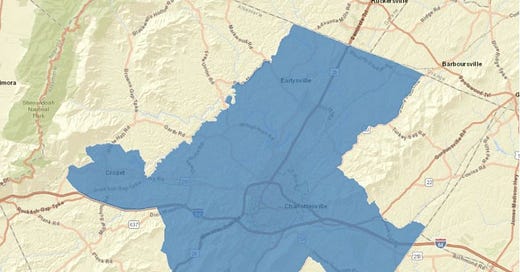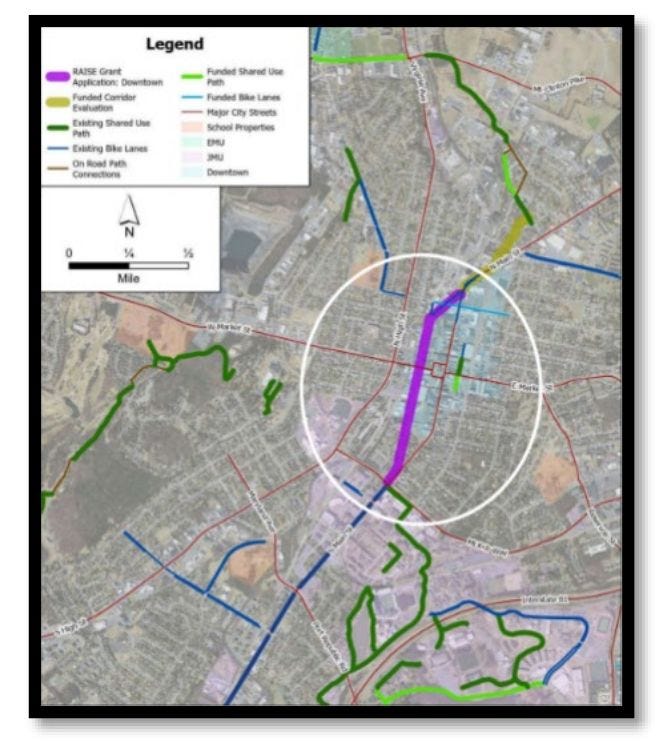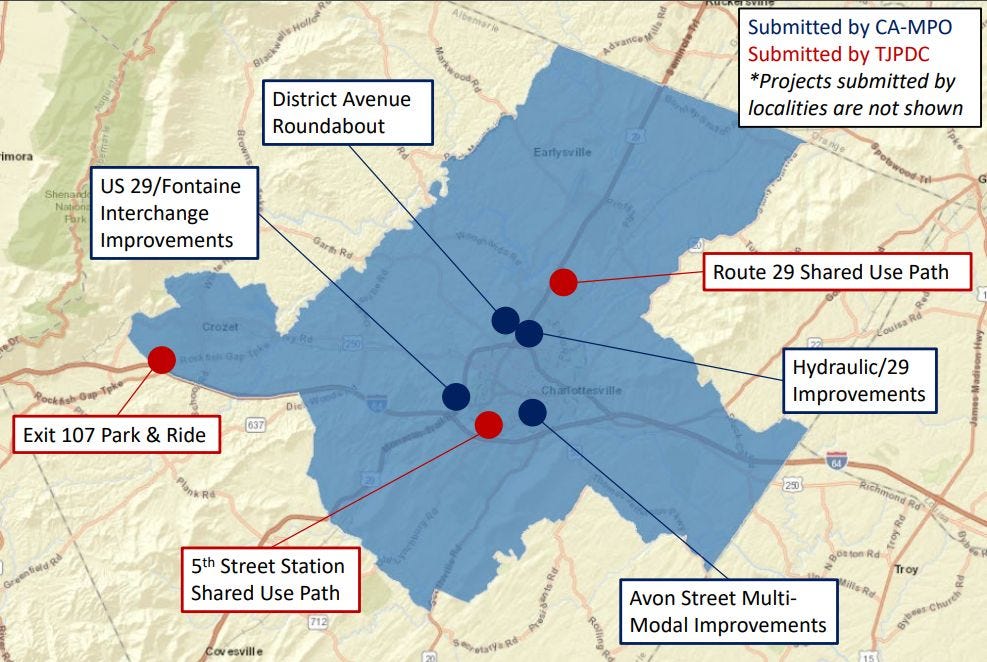Perpetuate pandemonium on this July 14, the 195th day of a year we’re counting as the 2,023rd. But today is National Pandemonium Day which has nothing to do with the black and white animal that is not actually a bear. You’ll have to wait until March 16 for National Panda Day, which I will hope will be less chaotic than this one. I’m Sean Tubbs and with training, you can be too.
In today’s edition:
The Virginia Department of Elections has published the official list of candidates for this year’s General Assembly races
A project to build a pedestrian bridge over the Rivanna River does not make the cut for the latest round of federal funds
The region’s transportation planning body wants your input on a survey about transportation priorities for the next long range plan
First shout-out: Camp Albemarle
Today’s first subscriber-supported public service announcement goes out to Camp Albemarle, which has for sixty years been a “wholesome rural, rustic and restful site for youth activities, church groups, civic events and occasional private programs.”
Located on 14 acres on the banks of the Moorman’s River near Free Union, Camp Albemarle continues as a legacy of being a Civilian Conservation Corps project that sought to promote the importance of rural activities. Camp Albemarle seeks support for a plan to winterize the Hamner Lodge, a structure built in 1941 by the CCC and used by every 4th and 5th grade student in Charlottesville and Albemarle for the study of ecology for over 20 years. If this campaign is successful, Camp Albemarle could operate year-round. Consider your support by visiting campalbemarleva.org/donate.
Virginia Department of Elections publishes list of General Assembly candidates this fall
There are 116 days until Election Day in Virginia when all 140 seats in the General Assembly will be on the ballot. The Virginia Department of Elections has released the full list of who qualified through primaries, conventions, or simply by being the only person to show up.
Statewide, there are only five out of 40 uncontested races in the Senate according to data compiled by the Virginia Public Access Project. That’s the lowest number since they began tracking elections in 1999. (view their data)
One of those uncontested races is for Senate District 10 where Republican John McGuire was selected in a convention in the spring. McGuire has been in the House of Delegates since being elected in 2017.
District 10 fully covers the counties of Amelia, Appomattox, Buckingham, Cumberland, Fluvanna, Goochland, Hanover and Powhatan. The District also covers the eastern half of Louisa County and the northwest portion of Prince Edward. McGuire has so far raised $358,056 in the race.
In Senate District 11, Democrat Creigh Deeds faces Republican Philip Hamilton. Deeds survived a primary challenge from Delegate Sally Hudson with 50.87 percent of the vote, or 465 votes. He spent more than a million during that campaign. Hamilton has raised $2,350 so far this year. District 11 covers all of Albemarle County, Charlottesville, Amherst County, and Nelson County as well as the western half of Louisa County.
Moving over to the House of Delegates, 34 of the 100 seats are uncontested. That’s a third for those who like fractions.
One of the uncontested seats is House District 54 which covers the city of Charlottesville and urbanized Albemarle County. Katrina Callsen placed first in a three way race with a plurality of the vote, or 47.32 percent. She’s currently the chair of the Albemarle School Board and a deputy city attorney in Charlottesville. Callsen raised $172,976 in the race and spent $155,418 in the primary.
House District 55 covers the rest of Albemarle County and parts of both Louisa County and Nelson County. There are also 19 registered voters in Fluvanna County near Scottsville. Democrat Amy Laufer and Republican Steve Harvey are on the ballot.
Laufer won nearly 70 percent of the vote in the primary. The former member of the Charlottesville School Board raised $317,169 and spent about $227,536 in the Democratic contest for the ballot.
Harvey entered the race at the last minute. In 2019, he challenged Democrat Ann Mallek for the White Hall seat on the Albemarle and got 43.17 percent of the vote. He had not raised any funds prior to the June 8 deadline for the most recent campaign finance reporting period.
House District 56 is another election that is uncontested and former 5th District Congressman Tom Garrett is the Republican and the only person on the ballot. He was selected in a convention over two other candidates.
District 56 covers Appomattox, Buckingham, and Cumberland counties as well as parts of Fluvanna, Goochland, and Prince Edward counties.
It is highly likely a version of this will end up in the next edition of Fifth District Community Engagement, my other newsletter.
Project to build bridge across Rivanna River fails to get federal grant
A proposal to construct a bridge across the Rivanna River to connect Pantops and the Woolen Mills has lost out in its second attempt at funding.
“We did not get the RAISE grant for preliminary engineering for the Rivanna River pedestrian bridge,” said Commissioner Rory Stolzenberg at the July 11 Planning Commission meeting.
RAISE stands for “Rebuilding American Infrastructure with Sustainability and Equity” and there were 162 awards made in late June across the United States totaling $2.2 billion.
The Thomas Jefferson Planning District Commission has been leading efforts to move the Rivanna bridge project forward. Earlier this year, the project did not score high enough in the Smart Scale process used by the Virginia Department of Transportation to qualify for funding.
Several projects in Virginia were funded in this RAISE cycle.
The Accomack-Northampton Planning District Commission will receive $23.25 million to convert the abandoned Bay Coast Railroad to a ten-foot shared use path between the town of Nassawadox and the Town of Olney. (page 149)
The City of Harrisonburg will receive $14.4 million for a streetscape and mobility transformation project that will convert one lane of U.S. 11 to a two-way separated bicycle facility. (page 150)
Chesterfield County will receive $3.6 million for planning for the Hopkins Interchange and Road Diet. This will pay for preliminary feasibility studies, environmental documentation, 60 percent construction documents, and public engagement work. (page 151)
The Town of Herndon will receive $720,000 to help with work on their 2050 Comprehensive Plan.
Last year, Albemarle County received a $2 million RAISE grant for planning for a trail between the Blue Ridge Tunnel to Charlottesville via Crozet. Take a look at my story from last August, and here’s a small update.
“Staff is working to finalize the grant agreement with the Federal Highway Administration in the first quarter of FY24,” writes county spokeswoman Abbey Stumpf in an email to me today. “Staff expects to release a [request for proposals] for consultants late in the first quarter of FY24.”
Now back to the Planning Commission meeting for a moment.
Stolzenberg made his comments during the period of time when Commissioners report from committees they are on. Commissioner Hosea Mitchel had nothing to report which meant no public update from the closed-door Land Use and Environmental Planning Committee.
Bill Palmer, the ex officio representative from the University of Virginia, was not present at the meeting.
That meant no report at all from the University of Virginia, the biggest driver of land use issues in Albemarle and Charlottesville. Here are some recent Charlottesville Community Engagement stories to keep you informed.
Second-year initiative moving forward; UVA Health Clinic at Zion Crossroads to expand, June 6, 2023
Grounds Framework Plan points way to future of UVA’s built environment, June 18, 2023
UVA Board of Visitors endorses design for Karsh Institute, July 4, 2023
Second shout-out: Design Develop
In today’s second Patreon-fueled shout-out, architectural firm Design Develop wants you to know about a new service aimed at the development community that may not be widely known yet — 3D point cloud scanning! That’s a technique that uses specialized equipment, such as 3D scanner systems, to gather a large amount of data points that represent the surface of the scanned object or scene.
The applications of 3D point cloud scanning are extensive and cover various fields, including architecture, construction, cultural heritage preservation, virtual reality, industrial design, manufacturing, and more. These applications require accurate 3D spatial information, and Design Develop’s workflow provides precise and comprehensive results, all while being more cost-effective than traditional methods.
Design Develop has expertise in this workflow for their own needs and now has a dedicated team offering this service in the Charlottesville and Albemarle Area. If you're involved in the real estate, design, or construction industry, feel free to contact us for more information or a free quote.
Visit their website for an introductory video that captures the 3D point cloud scanning of the Downtown Transit Center and a booklet that will explain more!
Planning group wants your input on transportation priorities
How do transportation projects get selected? That question covers one of the major themes of reporting here at Charlottesville Community Engagement as I seek to help more people understand how “they” decide what happens.
Who are “they” anyway? Can it be “us?”
Anyway, let’s start with one key document.
The U.S. Department of Transportation requires localities to have a document called the Long Range Transportation Plan to help prepare to meet the needs for the future population.
“The purpose of the plan is to consider the system-wide needs for improvements across all modes of the surface transportation system,” Sandy Shackleford, the director of planning and transportation for the Thomas Jefferson Planning District Commission. “These include bicycle and pedestrian infrastructure improvements, transit improvements, and road improvements.”
As part of this work, Shackleford organizes an entity called the Charlottesville-Albemarle Metropolitan Planning Organization that’s made up of elected officials who make the local decisions.
A webinar was held on June 20 that’s worth reviewing. As of this morning, only nine people had done so. (view the materials)
The federal government wants areas to plan for twenty years into the future but the TJPDC takes a longer view. (learn more).
“As a region we have chosen to use the planning horizon of 25 years when considering future roadway operations and conditions,” Shackelford said.
For the Charlottesville-Albemarle MPO, the next target year is 27 years away and the name for this plan is thus called Moving Toward 2050.
A primary reason for the long range transportation plan is to give the federal government a sense of what regional priorities are.
“As part of identifying our regional priority projects, we use the plan to answer questions about how we can improve general access to community destinations and jobs, how to improve safety for users of all travel moves, and how to better connect our bicycle and pedestrian networks,” Shackleford said.
To receive federal funding, a project must be in the long range transportation plan. That includes projects that go through the Virginia Department of Transportation’s Smart Scale process.
“There are a lot of valuable improvements we could be making but this process gives us the opportunity to have a regional discussion about what types of projects would have the most benefit,” Shackelford said.
The development of the next long range transportation plan will include public engagement. That work has already begun.
“We began public engagement in February by meeting with several stakeholder groups who represent different segments of our community to discuss the draft goals and objective language that was initially developed,” Shackelford said.
That engagement is now widening out to a larger group. The TJPDC is looking for input through a survey. (fill out the survey)
Take a look at the video to learn more about the process. Let’s get that view number up!
Reading material:
Microtransit ridership growing in two Virginia communities after 18-month pilot, Mass Transit, July 12, 2023
Virginia’s Youngkin surpasses previous governors’ annual fundraising records in a single quarter, Sarah Rankin, Associated Press, July 13, 2023
Virginia offers wetland permit guidance following Supreme Court’s Sackett ruling, Charlie Paullin, Virginia Mercury, July 14, 2023
Notes for #556
It would appear this newsletter is now a toddler now that we’re past the three-year mark. The pandemonium in my own life is soon going to settle down, showing the way to a much more orderly turn of events.
But as a one-person operation, there are often times I’m not ready to publish something. How will you know what’s coming? One good way to keep up is with my Notes page on Substack. Substack is always putting out new ways to get more people reading and sharing, and I recommend the app if you’ve not tried it already.
Five people this week became paid subscribers through Substack, which helps me move forward with being able to do the work and to imagine doing it for another three years or maybe more.
If you sign up through Substack, Ting will match your initial payment.
You may know by now that if you sign up for Ting at this link and enter the promo code COMMUNITY, you’ll get:
Free installation
A second month for free
A $75 gift card to the Downtown Mall



















Share this post